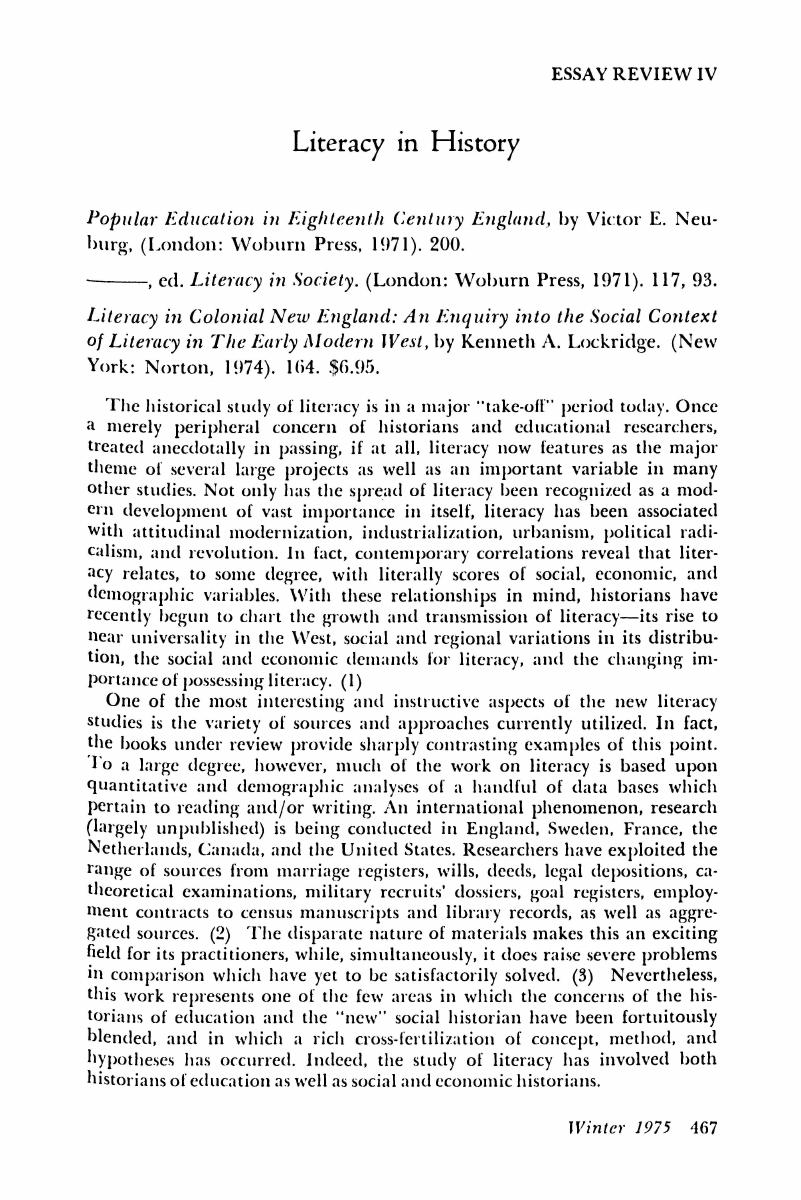Published online by Cambridge University Press: 02 June 2017

1. On these and related points, see my “Literacy and Social Structure in the Nineteenth-Century City,” Ph.D. Dissertation submitted to the University of Toronto, 1975.Google Scholar
2. For a more complete discussion, see ibid., esp. Introduction and Bibliography.Google Scholar
3. Ibid., “Preface to Part One: The Census as a Measure of Literacy;” my “What the 1861 Census Tells Us About Literacy,” Histoire Sociale (forthcoming, 1975); Lockridge, Literacy in Colonial New England, Appendix B; and Schofield, R. S., “The Measurement of Literacy in Pre-Industrial England,” in Literacy in Traditional Societies, ed, Goody, Jack (Cambridge, 1968), 311–325. [Ed. note. For an informative review of Goodys book, see McCall, Daniel F., “Literacy and Social Structure, HEQ, 11 (Spring 1971): 85–92.]Google Scholar
4. Altick, R. D., The English Common Reader (Chicago, 1957); Shepard, Leslie, The History of Street Literature (Detroit, 1973); Collison, Robert, The Story of Street Literature (London, 1973); Kaufman, Paul, Libraries and Their Users (London, 1969); and Ellegard, Alvar, “The Readership of the Periodical Press in Mid-Victorian Britain, Gotesborgs Universites Arsskrift, 63 (1957).Google Scholar
5. See Fogel, Robert W., “The Limits of Quantitative Methods in History,” American Historical Review, 80 (1975); 329–350.CrossRefGoogle Scholar
6. See my “Literacy and Social Structure,” Chap. 7 for a discussion of the quality of literacy in the past; see also, Calhoun, Daniel, The Intelligence of a People (Princeton, 1973).Google Scholar
7. Ibid., Introduction; Schofield, “The Measurement of Literacy in Pre-industrial England.”Google Scholar
8. Neuburg, 's “The Literature of the Streets,” in The Victorian City, ed. Dyos, H. J. and Wolff, Michael (London, 1973), 191–210, is much more sophisticated in its argument; indeed, it is more relevant to the later period.Google Scholar
9. Neuberg, Victor, The Penny Histories, (Oxford, 1968).Google Scholar
10. Rudé, George and Hobsbawm, E. J., Captain Swing (New York, 1969).Google Scholar
11. Thompson, E. P., The Making of the English Working Class (New York, 1967).Google Scholar
12. Schofield, R. S., “Dimensions of Illiteracy, 1750–1850,” Explorations in Economic History, 10(1973), 437–454, and Sanderson, Michael, “Literacy and Social Mobility in The Industrial Revolution in Britain,” Past and Present, 56 (1972): 75–104.Google Scholar
13. Scott Smith, Daniel, “Underregistration and Bias in Probate Records,” William and Mary Quarterly (1975): 100–110.Google Scholar
14. See Graff, , “What the 1861 Census Tells Us About Literacy;” Schofield, , “The Measurement of Literacy in Pre-industrial England” and Lockridge, Appendix B.Google Scholar